accessFlow was created by developers for developers so that they can build accessible digital environments from the ground up and in a way that seamlessly fits into their workflow.
Powered by accessiBe’s AI technology, accessFlow scans code, highlights accessibility issues, and shows developers exactly how to fix them. That way, they can resolve problems efficiently, even without any prior accessibility knowledge or experience.
accessFlow also greatly assists developer team leads, providing them with full visibility and control.
By integrating accessibility into the software development lifecycle (SDLC) from the outset, accessFlow enables teams to address accessibility proactively, catching issues early, reducing the risk of non-compliance, and improving overall development efficiency.
Just as importantly, accessFlow is built to fit into existing workflows.
It integrates directly with the tools your team already uses, like Jira, GitHub, and monday.com, with no third-party implementation or custom setup required. Like your testing or threat detection tools, it just works in the background, without disrupting how your team ships code.
accessFlow also helps teams scale remediation efficiently through automation.
Developers can auto-resolve recurring, low-complexity issues, with every change tracked for review at any time.
And now, with the accessFlow SDK, teams can “shift left” by running accessibility checks during automated tests, while accessFlow's MCP brings accessibility guidance directly into the IDE so AI assistants can reference your project’s accessFlow data as you code.
How does accessFlow work?
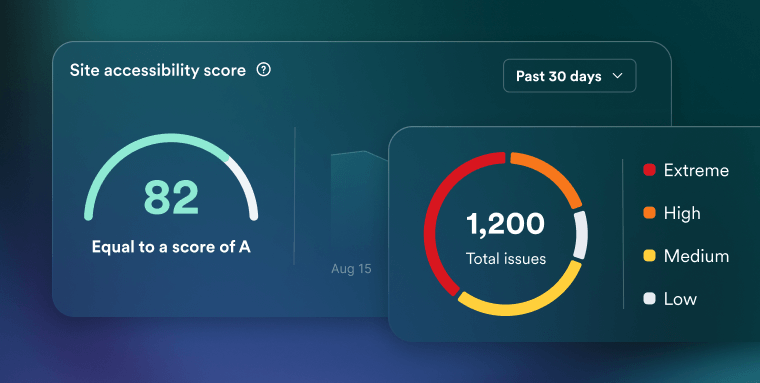
accessFlow uses an AI-powered engine to automatically scan your website for accessibility and compliance issues based on the Web Content Accessibility Guidelines (WCAG). It detects problems, prioritizes them by severity, and provides clear guidance for resolution, all before deployment.
The auditing process begins with your homepage, then continues by following internal links to crawl your entire website.
Using a headless Chrome browser, accessFlow simulates real user interactions to generate a realistic and comprehensive assessment of accessibility across all pages.
Importantly, accessFlow operates externally; it doesn’t require any code to be hosted on your site and won’t modify your existing code.
Three ways to tackle accessibility issues
accessFlow gives teams flexibility in how they approach remediation, based on their priorities and workflow:
- By severity: Start with the most critical issues that significantly impact usability or compliance, and work your way down to less severe ones
- By rule: Focus on specific categories of issues, such as missing ARIA labels, unlabeled form elements, or color contrast errors. This method helps uncover patterns in your codebase and enables you to apply consistent fixes across multiple areas of your site
- By web page: Tackle issues within a specific page or selection of your website. This approach is ideal for developers working on distinct components or features, allowing them to stay focused and remediate without disrupting their workflow
NEW: Developers can now take this one step further with the accessFlow SDK — integrating automated accessibility checks directly into their CI/CD workflows. It runs alongside testing frameworks like Playwright, Cypress, or Selenium, generating detailed reports and enforcing build thresholds based on issue severity. This ensures accessibility testing happens continuously, not just after deployment.
Get to know accessFlow
acessFlow is built of a number of core features. Let’s walk you through them:
The dashboard
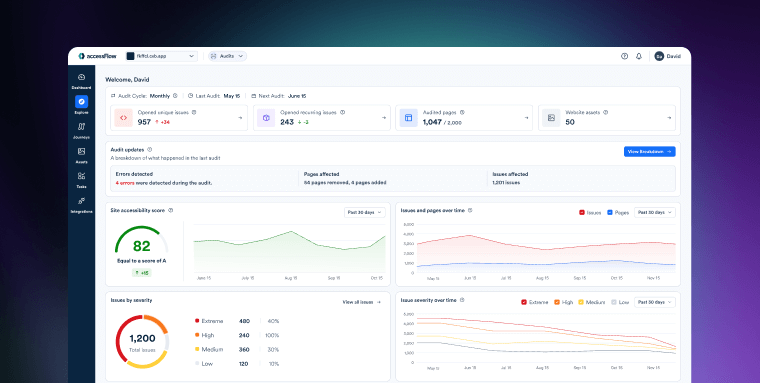
accessFlow’s central hub offers a comprehensive overview of your website's accessibility posture. It displays:
- A live accessibility score based on issue volume and severity
- A breakdown of problems by severity level
- Trends over time showing how accessibility has improved or regressed
- A comparison between identified problems and the number of pages scanned
- A timeline view showing changes across a defined audit period
Besides being the “home base” for project managers, team leads, and developers, the dashboard provides all stakeholders with a high-level, update view of their accessibility project.
Those who lack technical expertise and a deep understanding of web accessibility can see the state of their site’s accessibility through the posture report. They can also gain a clear picture of a given project’s timeline through the ‘progress over time’ and ‘team progress’ charts - updated in real time.
The Explore page:
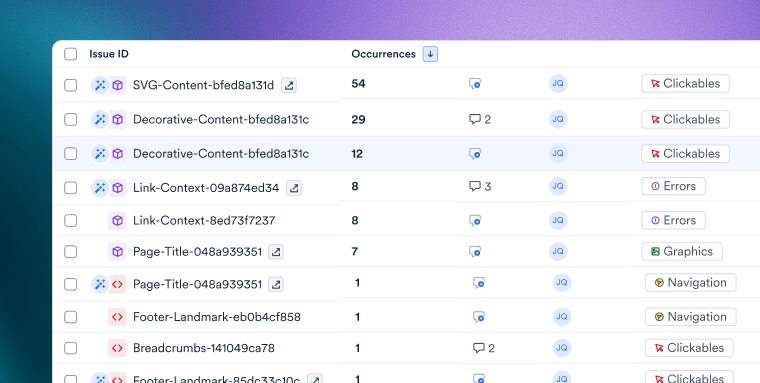
The Explore page gives you a granular view of accessibility issues across your site. You can group and filter issues by:
This Explore page is particularly useful for team leaders, empowering them to delegate tasks to specific team members according to their needs and shifting priorities.
They can view all tasks in a unified list, or separated according to the web pages they appear on.
This is also where team leads can export tasks to Jira, monday.com, or the CRM they use, to really integrate accessibility into their workflows.
Auto-resolve issues from the Explore page:
The Explore page is also where you will see the issues best addressed through auto-resolve. Relevant problems will be tagged with an icon, which will read ‘Eligible for auto-resolve’, when hovered over. All you’ll need to do is select the relevant issues and press on ‘Auto-resolve’ appearing at the bottom of your screen.
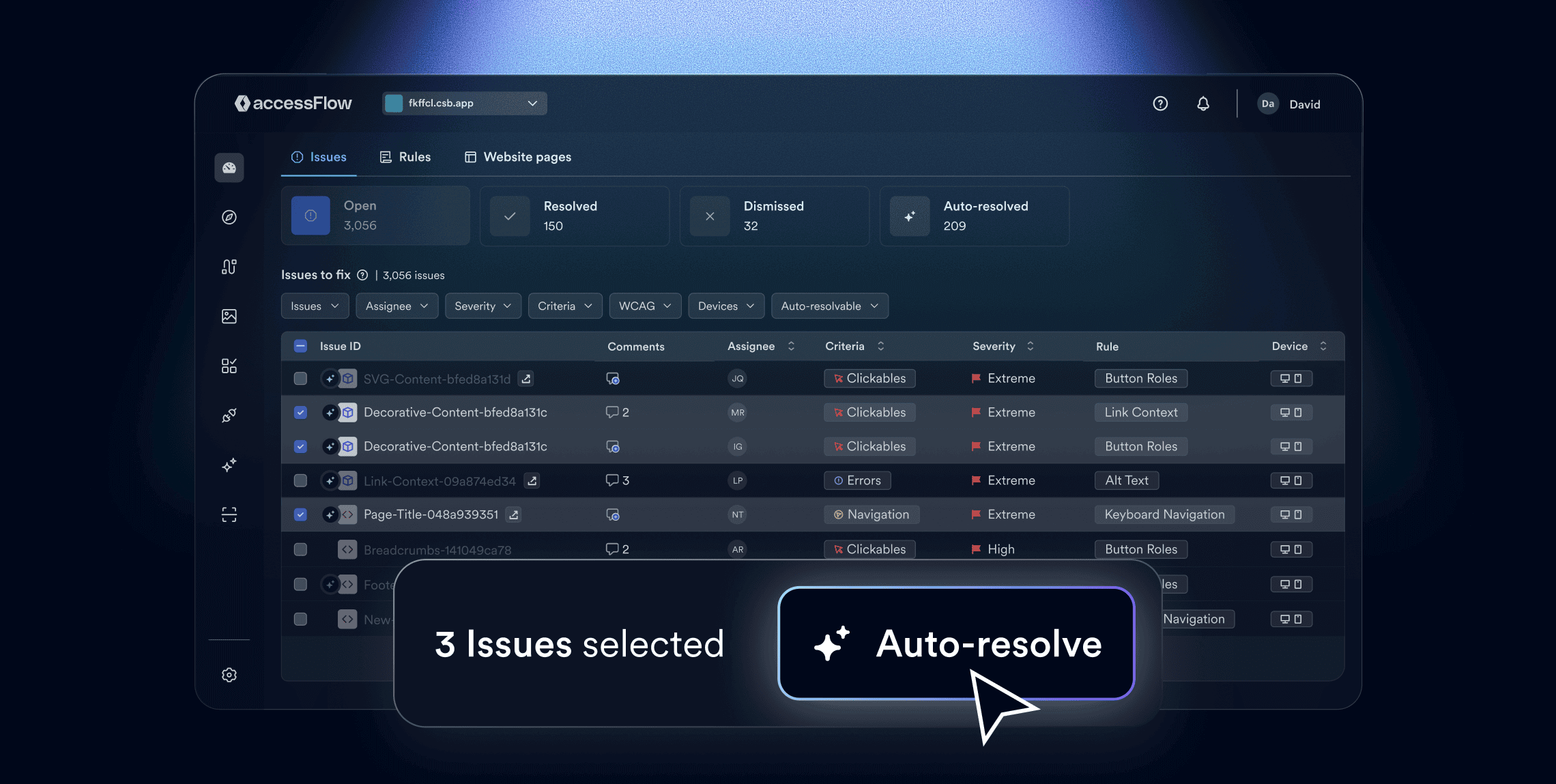
NEW: AI false positive validation
Sometimes a flagged item isn’t a real accessibility error. You can mark an issue as a potential false positive; accessFlow’s AI will analyze the element, its context, and the WCAG rule to confirm whether it’s genuine or can be safely dismissed. This reduces audit noise and keeps your backlog focused on real barriers. (Initial support includes rules like footer landmark and empty links; per-user daily limits apply.)
Press here to learn more about this feature.
The Remediation Panel
Accessible from both the dashboard and Explore page, the Remediation Panel is where developers take action.
For each issue, it provides clear descriptions, relevant WCAG references, and suggested code fixes, enabling fast, accurate remediation, even without prior accessibility experience.
Additionally, developers are presented with detailed explanations to help them avoid replicating a given issue moving forward.
New: AI-powered alt text suggestions
When accessFlow detects missing image descriptions, it suggests high-quality, contextual alt text in the Remediation Panel. Review up to three options, regenerate if needed, and apply the best fit; suggestions align with accessibility best practices to speed up inclusive content creation.
Press here to learn more about this feature.
Journeys
Journeys let you audit key user flows to ensure that complex, multi-step interactions are accessible and compliant. These can include:
- Account creation and login
- Checkout and payment flows
- Form submissions or surveys
- Content filtering and search
- Navigation through multi-page processes
- Triggering dynamic elements like popups
Developers and team leads can record these flows using a session recorder or define them manually, gaining full control over which interactions to test and monitor.
New: Integrate accessibility intelligence into your IDE
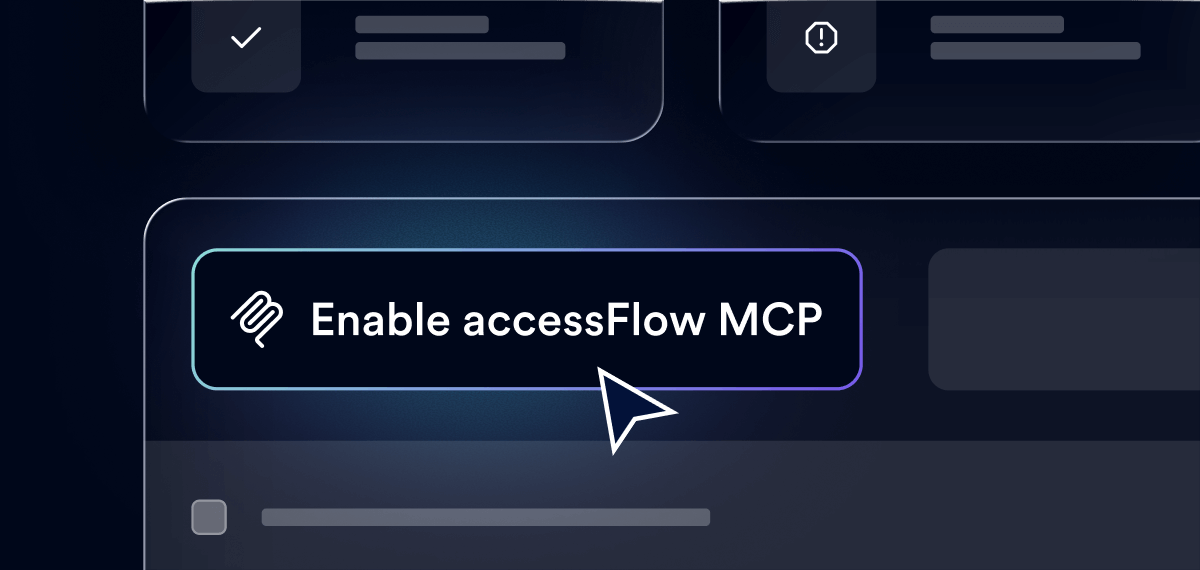
accessFlow’s MCP brings the platform's accessibility expertise directly into your IDE. It connects AI assistants like GitHub Copilot and Cursor to your live project data, turning them into accessibility-aware copilots that guide you as you code. Instead of switching tabs or digging through reports, you can simply ask for help in context — like “Explain AF-12345” or “Show me how to fix missing labels” — and get WCAG-based explanations with suggested code changes pulled from your own accessFlow data.
By embedding accessibility intelligence where developers already work, MCP keeps your workflow fast, accurate, and secure. It helps surface, prioritize, and resolve issues in real time, while token-based authentication protects your data and ensures every recommendation aligns with verified WCAG standards.
Press here to learn more about accessFlow's MCP.
accesiBe uses accessFlow, too
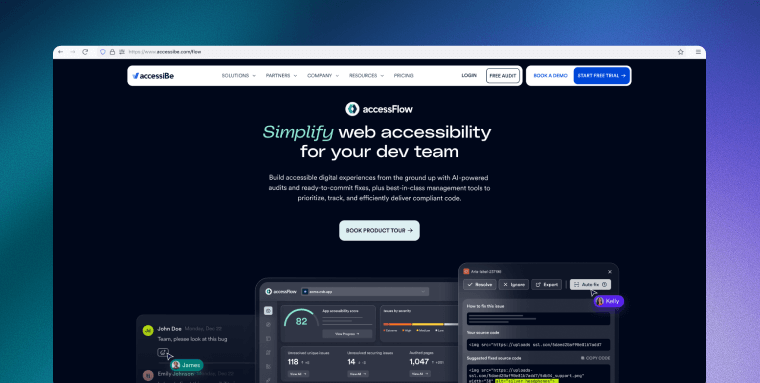
You may have heard that we’ve launched our new website.
To create a site that is natively accessible (and one that befits a brand championing web accessibility), our developers relied on accessFlow throughout the entire process.
This resulted in a website that looks awesome - if you’ll excuse a little bragging on our part - and, more importantly, which strictly follows accessibility guidelines.
Start your accessibility journey now
More and more organizations are realizing the importance of shifting left on accessibility.
With accessFlow, you empower your team to identify and resolve accessibility issues early in the development process, before they become blockers or liabilities.
Whether you're building new features or managing large-scale projects, accessFlow helps you make accessibility a natural part of how your team works: Efficiently, collaboratively, and at scale.
Frequently asked questions about accessFlow
Q1. What is accessFlow and who is it made for?
A1. accessFlow is an AI-powered accessibility management tool designed for developers, team leads and product managers. It helps identify, prioritize and remediate accessibility issues according to WCAG standards, while integrating into existing development workflows.
Q2. How does accessFlow help a team catch accessibility issues earlier?
A2. It provides automated audits that scan pages and user flows, surfaces issues via an Explore dashboard, and offers code-level fix guidance via a remediation panel. By integrating into CI/CD and sprint workflows, it makes accessibility checks routine rather than after-thoughts.
Q3. Can accessFlow integrate with my project management or ticketing tools?
A3. Yes. accessFlow supports integration with ticketing systems like Jira, GitHub issues and other task-tracking tools, enabling accessibility issues to be assigned, tracked and resolved alongside regular development tasks.
Q4. What does accessFlow do about repetitive or low-complexity issues?
A4. It features an auto-resolve capability that allows bulk remediation of pattern-based issues (like missing alt text, empty links or color contrast violations) via a one-time embed script, enabling teams to clear backlog faster while focusing on more complex problems.
Q5. Does accessFlow help validate full user flows or just individual pages/components?
A5. Yes — it supports Journeys, where critical multi-step user flows (e.g., checkout, login, form completion) can be defined or recorded and then tested end-to-end for accessibility issues. That ensures not only component-level compliance but real-world usability.
Q6. Do developers need deep accessibility expertise to use accessFlow?
A6. No. While accessibility expertise helps, accessFlow is built to guide developers and teams with actionable instructions, links to the relevant WCAG criteria and suggestion of code fixes, thus lowering the barrier to integrating accessibility in a meaningful way.
Q7. Why should organizations consider using accessFlow as part of their accessibility strategy?
A7. Because accessibility risk is high and code-level issues often multiply quickly as sites evolve, accessFlow offers a scalable solution: end-to-end remediation, ongoing monitoring, integration with existing workflows—and with accessiBe’s backing, the best in AI and human expertise helps ensure your site stays accessible and compliant.








